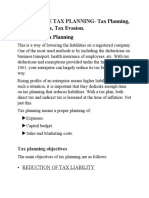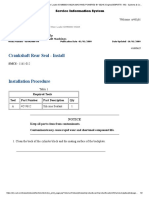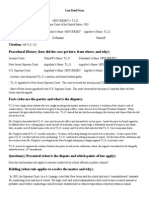0 ratings0% found this document useful (0 votes)
811 viewsProcedural Implementation
Procedural Implementation
Uploaded by
Vishal SharmaProcedural Implementation deals with the regulatory framework that Indian companies must consider when implementing strategies. Organizations must understand the procedures for obtaining government approval for plans, programs, and projects. These procedures include licensing, foreign collaboration, capital controls, imports/exports, and incentives. Companies must navigate various acts related to industries, monopolies, capital issues, and trade to receive necessary approvals before moving forward with strategic implementation in India. The government aims to promote employment, regional development, exports, and capacity utilization through these regulatory and promotional policies.
Copyright:
© All Rights Reserved
Available Formats
Download as PPT, PDF, TXT or read online from Scribd
Procedural Implementation
Procedural Implementation
Uploaded by
Vishal Sharma0 ratings0% found this document useful (0 votes)
811 views17 pagesProcedural Implementation deals with the regulatory framework that Indian companies must consider when implementing strategies. Organizations must understand the procedures for obtaining government approval for plans, programs, and projects. These procedures include licensing, foreign collaboration, capital controls, imports/exports, and incentives. Companies must navigate various acts related to industries, monopolies, capital issues, and trade to receive necessary approvals before moving forward with strategic implementation in India. The government aims to promote employment, regional development, exports, and capacity utilization through these regulatory and promotional policies.
Original Description:
Procedural implimentation
Original Title
572802_634224489743631250
Copyright
© © All Rights Reserved
Available Formats
PPT, PDF, TXT or read online from Scribd
Share this document
Did you find this document useful?
Is this content inappropriate?
Procedural Implementation deals with the regulatory framework that Indian companies must consider when implementing strategies. Organizations must understand the procedures for obtaining government approval for plans, programs, and projects. These procedures include licensing, foreign collaboration, capital controls, imports/exports, and incentives. Companies must navigate various acts related to industries, monopolies, capital issues, and trade to receive necessary approvals before moving forward with strategic implementation in India. The government aims to promote employment, regional development, exports, and capacity utilization through these regulatory and promotional policies.
Copyright:
© All Rights Reserved
Available Formats
Download as PPT, PDF, TXT or read online from Scribd
Download as ppt, pdf, or txt
0 ratings0% found this document useful (0 votes)
811 views17 pagesProcedural Implementation
Procedural Implementation
Uploaded by
Vishal SharmaProcedural Implementation deals with the regulatory framework that Indian companies must consider when implementing strategies. Organizations must understand the procedures for obtaining government approval for plans, programs, and projects. These procedures include licensing, foreign collaboration, capital controls, imports/exports, and incentives. Companies must navigate various acts related to industries, monopolies, capital issues, and trade to receive necessary approvals before moving forward with strategic implementation in India. The government aims to promote employment, regional development, exports, and capacity utilization through these regulatory and promotional policies.
Copyright:
© All Rights Reserved
Available Formats
Download as PPT, PDF, TXT or read online from Scribd
Download as ppt, pdf, or txt
You are on page 1of 17
Procedural Implementation
Procedural Implementation deals with the
different aspects of the regulatory framework
that Indian companies have to consider.
Any organisation which is planning to
implement strategies must be aware of the
regulatory framework within which the plans,
programmes , and projects have to be
approved by the government (central and
state).
Following the procedures laid down for
implementation constitutes an important
component of strategy implementation in
the Indian context :
1) Licensing Procedure
2) Foreign Collaboration Procedure
3) FERA Requirements
4) MRTP Requirements
5) Capital Issue Control Requirements
6) Import and Export Requirements
7) Incentives and Facilities Benefits
The system of planning rests on three policy documents
Section 30 of the IDR Act, 1951 deals with the Registration &
Licensing of industrial undertaking rules.
Under this Act, a license is necessary for establishing a new
unit, manufacturing a new article, substantial expansion of
capacity in existing business, and changing location.
Industrial Policy
Resolution, 1956
Industries
(Development &
Regulation) Act,
1951
Industrial
Licensing Policy,
1973
The licensing procedure requires the applicant to approach
the Secretariat for Industrial Approvals (SIA), which is
common for receiving & processing all types of applications
related to industrial projects.
Composite applications are dealt by the Project Appraisal
Board
Application considered by a number of govt. agencies &
ministries before a Letter of Intent is issued
After conditions are fulfilled , the Letter of Intent is
converted into an industrial license
The govt. policy, in general, allows foreign investment &
collaboration on a selective basis in priority areas, export
oriented or high technology industries, and permitting existing
foreign investment in non-priority areas up to 40% of the
equity holding. This limit has been raised to 51% in 34 high-
priority industries.
All proposals to set up projects with foreign collaboration
require prior government approval.
The regulatory framework deals with the need for foreign
technology, royalty payments, terms & conditions for
collaborative agreement & foreign investment.
Preliminary evaluation by the promoter, obtaining
industrial licence (if necessary), or registration with
the Directorate General of Technical Development
Obtaining clearance under the MRTP Act
Applying for foreign collaboration to Foreign
Investment Board
Applying for import of capital goods (if required)
Finalisation of agreement and clearance from the
Reserve Bank of India (RBI).
The Monopolies & Restrictive Trade Practices
(MRTP) Act,1969 seeks to prevent monopolistic &
restrictive trade practices, & the concentration of
economic power.
The MRTP Act requires that any substantial
expansion which increases the assets or productive
capacity or supply for distribution not less than 25%,
requires the approval of the central govt.
The MRTP Act applies to four types of
undertakings:
An undertaking having gross assets of Rs. 100 crore
& above
Interconnected Undertakings which together have
assets of Rs. 100 crore or above
A dominant undertaking (one which produce,
supplies, or controls one-third of any goods in the
country) having assets of Rs. 1 crore & above
Interconnected dominant undertakings.
The issue of capital by companies is regulated through
the Capital Issues Control Act, 1956 & the Securities
Contracts Regulation Act, 1956 for the purpose of
ensuring that investments are made in priority areas,
& for the promotion of capital markets & protection
of shareholders.
For the purpose of strategy implementation, these acts
are relevant so far as the provision of financial
resources is concerned.
Apart from this, these acts also affect mergers &
amalgamations as they regulate the capital
reorganization plans for mergers.
The Controller of Capital Issues (CCI) under
the Dept. of Economic Affairs, Ministry of
Finance, is the nodal agency for the
administration of the acts.
All proposals for fresh issues of equity or
preference capital, issue of right shares, bonus
shares, debentures, etc. & capitalization of free
reserves have to be scrutinized by the CCI.
The legal framework for imports & exports in India is
provided by the Import & Export (Control) Act, 1947.
The Import Trade Control Policy Book (popularly called the
Red Book) is an annual govt. publication which outlines the
import licensing policy for individual industries & for
different categories of importers (established, actual users &
registered).
Through the Import & Export Control Order, the govt. has
delegated the power to issue licenses & to administer the act
to the Chief Controller of Imports & Exports.
For capital goods imports, the Capital goods
committee exercises the powers.
The Secretariat for industrial approvals handles the
procedural formalities.
The detailed procedure for import licenses for capital
goods and raw materials is provided in Import Trade
Control Handbook of Rules & Procedures.
Project Implementation for putting a strategy
into action requires a consideration of various
incentives, subsidies, & facilities which can
benefit an organisation.
In providing incentives, etc. the govt. does not
play a regulatory or controlling role but a
promotional role, which is manifested in
various forms.
In line with the objectives laid out in the Industrial
Policy resolution, the govt. attempts to achieve
employment generation, correction of regional
imbalances, promotion of export-oriented industries
& utilization of installed capacity through higher
production levels & productivity.
The Fiscal, Monetary & Budgetory policies of the
govt. are aimed at promotion.
The govt. also plays a promotional role in terms of
purchasing, pricing, distribution, availability of raw
materials & provision of infrastructural facilities.
From above sections, it is to be observed that
the role of the govt. is quite comprehensive
and affects practically each and every aspect
of an organization's management especially
activities related to strategic management.
You might also like
- Functional and Operational ImplementationDocument14 pagesFunctional and Operational ImplementationAshish SinghNo ratings yet
- Indianism and Indian ManagementDocument12 pagesIndianism and Indian Managementtaraalibeig100% (2)
- Strategic Advantage AnalysisDocument21 pagesStrategic Advantage Analysisvaishalic100% (1)
- Corporate Accounting Redemption of DebenturesDocument5 pagesCorporate Accounting Redemption of DebenturesRajesh Ambrose100% (1)
- 19P0310314 - Corporate Tax Planning - Meaning, Objectives and ScopeDocument8 pages19P0310314 - Corporate Tax Planning - Meaning, Objectives and ScopePriya KudnekarNo ratings yet
- Organisational Systems in EvaluationDocument9 pagesOrganisational Systems in EvaluationakhilNo ratings yet
- Features of SHRMDocument1 pageFeatures of SHRMTitus ClementNo ratings yet
- Multiple Projects and Constraints StructureDocument12 pagesMultiple Projects and Constraints StructurePriya JainNo ratings yet
- Joint Mangement CouncilsDocument10 pagesJoint Mangement CouncilstaussiNo ratings yet
- Indian Insight Into TQMDocument13 pagesIndian Insight Into TQMSrinivas Reddy Rondla100% (1)
- Q.1: What Techniques Increased Mr. Mukherji's Communication Effectiveness? AnsDocument5 pagesQ.1: What Techniques Increased Mr. Mukherji's Communication Effectiveness? AnsChandanMatoliaNo ratings yet
- Competition Act 2002Document19 pagesCompetition Act 2002Vatsal ChauhanNo ratings yet
- HRD Mechanism Unit 3 HRDDocument6 pagesHRD Mechanism Unit 3 HRDvandana kadamNo ratings yet
- New Issues in Marketing GlobalisationDocument20 pagesNew Issues in Marketing Globalisationkareena23No ratings yet
- Generation and Screening of ProjectDocument27 pagesGeneration and Screening of ProjectsargunkaurNo ratings yet
- Determination of Inter and Intra Industry Compensation DifferentialsDocument13 pagesDetermination of Inter and Intra Industry Compensation DifferentialsShruti LatherNo ratings yet
- IRBIDocument15 pagesIRBIVicky Hatwal100% (2)
- Strategic Management PPT by Akshaya KumarDocument23 pagesStrategic Management PPT by Akshaya KumarAkshaya KumarNo ratings yet
- MIS Basics and MIS Other Academic DisciplinesDocument26 pagesMIS Basics and MIS Other Academic DisciplinesSarikaSaxena100% (1)
- CPPM and Hermanson's Goodwill ModelDocument12 pagesCPPM and Hermanson's Goodwill ModelAnuja Bhakuni0% (2)
- Activity Areas of HRDDocument16 pagesActivity Areas of HRDDrPurnima SharmaNo ratings yet
- ED CycleDocument5 pagesED CycleNayan BhalotiaNo ratings yet
- ENTREPRENEURship Notes Mba 2nd SemDocument130 pagesENTREPRENEURship Notes Mba 2nd SemKajal NainNo ratings yet
- Industrial FinanceDocument6 pagesIndustrial Financerathnakotari50% (2)
- Training Climate and PedagogyDocument8 pagesTraining Climate and Pedagogyyuda rahadian100% (1)
- Tools and Techniques of Capital Expenditure ControlDocument11 pagesTools and Techniques of Capital Expenditure ControlHari PurwadiNo ratings yet
- Aims of Finance FunctionDocument56 pagesAims of Finance FunctionBV3S100% (2)
- Approaches To Grievance MachineryDocument2 pagesApproaches To Grievance MachinerySumathy S Ramkumar0% (1)
- Clpa Xii New Branches of AuditingDocument7 pagesClpa Xii New Branches of AuditingSARFARAZ AHMADNo ratings yet
- Business Environment With Reference To Global IntegrationDocument15 pagesBusiness Environment With Reference To Global IntegrationBhupendra ChauhanNo ratings yet
- Expatriate and Repatriate Support and Development: ExpatriatesDocument5 pagesExpatriate and Repatriate Support and Development: ExpatriatesrishiganeshNo ratings yet
- Role of Family & Society in Developing EntrepreneurshipDocument4 pagesRole of Family & Society in Developing EntrepreneurshipVijay Bala DevakumarNo ratings yet
- HRD MatrixDocument1 pageHRD MatrixMann Jett PradhanNo ratings yet
- Ways To Raise Finance From International MarketDocument7 pagesWays To Raise Finance From International Marketankitonway100% (1)
- DAGMAR ApproachDocument8 pagesDAGMAR Approachneha jainNo ratings yet
- Industrial SicknessDocument10 pagesIndustrial SicknessAditya0% (1)
- H.R.P. at Different LevelsDocument3 pagesH.R.P. at Different LevelsShalini Swaroop0% (1)
- Cross Leveraging KnowldgeDocument6 pagesCross Leveraging KnowldgeJuhi Chawla67% (3)
- HRP Macro Level PlanningDocument15 pagesHRP Macro Level PlanningNeenu Wilson100% (1)
- Principles of Wage & Salary AdministrationDocument7 pagesPrinciples of Wage & Salary AdministrationPrince MittalNo ratings yet
- Role of Organizational Systems in Strategic EvaluationDocument1 pageRole of Organizational Systems in Strategic EvaluationNAIMNo ratings yet
- HUMAN RESOURCE Accounting and AuditDocument45 pagesHUMAN RESOURCE Accounting and AuditNishu Singla100% (1)
- Multiplicity of Financial InstrumentsDocument30 pagesMultiplicity of Financial InstrumentsSarath KumarNo ratings yet
- Industrial Disputes Types and FormsDocument14 pagesIndustrial Disputes Types and FormsViraja GuruNo ratings yet
- Strategic EvaluationDocument12 pagesStrategic EvaluationFebson Lee Mathew100% (1)
- Responsibility Accounting - Types, Features, Prerequisites & ExamplesDocument8 pagesResponsibility Accounting - Types, Features, Prerequisites & Examplesprakashzodpe2013No ratings yet
- BA 4003 Banking and Financial ServicesDocument2 pagesBA 4003 Banking and Financial ServicesSiranjeevi G100% (1)
- Human Resource Accounting: Meaning, Definition, Objectives and Limitations! MeaningDocument5 pagesHuman Resource Accounting: Meaning, Definition, Objectives and Limitations! MeaningJahanvi BansalNo ratings yet
- Behavioural Issues in Strategy Implementation - 121791546Document36 pagesBehavioural Issues in Strategy Implementation - 121791546Neha UjjwalNo ratings yet
- Consumer Behaviour Unit - 2 PDFDocument22 pagesConsumer Behaviour Unit - 2 PDFPrashant TripathiNo ratings yet
- Human Resource Development in INDIADocument22 pagesHuman Resource Development in INDIAGangadharNo ratings yet
- Multiple Project & ConstraintsDocument11 pagesMultiple Project & ConstraintsVinayGolchha100% (1)
- Call Money MarketDocument24 pagesCall Money MarketiyervsrNo ratings yet
- Chapter 8 - Evaluating Supervising and Controlling Sales and SalesDocument26 pagesChapter 8 - Evaluating Supervising and Controlling Sales and SalesSubashNo ratings yet
- Marketing Appraisal of A ProjectDocument34 pagesMarketing Appraisal of A ProjectJonas George S. SorianoNo ratings yet
- EDDocument8 pagesEDNaganandaKu67% (3)
- Work Ethos: Work Ethos Will Be Different at Different LevelsDocument2 pagesWork Ethos: Work Ethos Will Be Different at Different LevelsakhilNo ratings yet
- Procedural Implementation: Prestige Institute of Management GwaliorDocument18 pagesProcedural Implementation: Prestige Institute of Management GwaliorBhupinder SinghNo ratings yet
- Procedural ImplementationDocument18 pagesProcedural ImplementationAni Singh50% (2)
- Industrial Policy of India: Vasu Singla Nikhil Aggarwal Akash Joshi Jagseer Singh Gagandeep NainDocument40 pagesIndustrial Policy of India: Vasu Singla Nikhil Aggarwal Akash Joshi Jagseer Singh Gagandeep NainVasu SinglaNo ratings yet
- A Presentation On: "Spiritual Tourism in India"Document12 pagesA Presentation On: "Spiritual Tourism in India"Vishal SharmaNo ratings yet
- JOB - HOPPING PresentatoionDocument10 pagesJOB - HOPPING PresentatoionVishal SharmaNo ratings yet
- AnovaDocument47 pagesAnovaJacob YoungNo ratings yet
- Production ProcessDocument4 pagesProduction ProcessVishal SharmaNo ratings yet
- Group - Discussion Rules & Tips For JobseekersDocument2 pagesGroup - Discussion Rules & Tips For JobseekersVishal SharmaNo ratings yet
- Bench Marking of HR PracticesDocument50 pagesBench Marking of HR PracticesVishal SharmaNo ratings yet
- 14 x11 Financial Management BDocument10 pages14 x11 Financial Management BPj WooNo ratings yet
- Art of Arabic CalligraphyDocument5 pagesArt of Arabic CalligraphyAaea LisboaNo ratings yet
- 108 Spouses Abad v. CADocument2 pages108 Spouses Abad v. CALawdemhar CabatosNo ratings yet
- Science Test-Chapter 1 MatterDocument5 pagesScience Test-Chapter 1 MatterRentika Siahaan100% (2)
- 03 DUDir South Campus, 2020 IIDocument11 pages03 DUDir South Campus, 2020 IInew traineeeNo ratings yet
- Literature Review On After Sales ServiceDocument6 pagesLiterature Review On After Sales Serviceafmzwlpopdufat100% (1)
- Phytophthora Infestans: Late Blight of PotatoDocument9 pagesPhytophthora Infestans: Late Blight of PotatoHaider ALiNo ratings yet
- RN518 MWDocument54 pagesRN518 MWDominiqueNo ratings yet
- Exam: 646-203 Title: Cisco Sales Expert Ver: 06.10.09Document86 pagesExam: 646-203 Title: Cisco Sales Expert Ver: 06.10.09Ovidiu ManolescuNo ratings yet
- Rajasthan CattleDocument60 pagesRajasthan CattleSANo ratings yet
- What Every Child Needs!: Teaching & Learning CompanyDocument16 pagesWhat Every Child Needs!: Teaching & Learning Companyumm_aasiyaNo ratings yet
- ARTICLE REVIEW ENT530 (Baru 2) PDFDocument11 pagesARTICLE REVIEW ENT530 (Baru 2) PDFLiyana FarisyaNo ratings yet
- Graphic Organizer CompletedDocument2 pagesGraphic Organizer Completedapi-518507034No ratings yet
- 6.2 - MSDS CrystalDocument2 pages6.2 - MSDS CrystalDESTGEERNo ratings yet
- Mani 003 B8Document21 pagesMani 003 B8SANJAY KUMARNo ratings yet
- Week 2 Part 2 4th UpdatedDocument9 pagesWeek 2 Part 2 4th Updatedmomo AdamNo ratings yet
- A Little Sweet 有點甜 (You Dian Tian)Document5 pagesA Little Sweet 有點甜 (You Dian Tian)hafish varintioNo ratings yet
- ENT530 SOCIAL MEDIA REPORT Pages 1-25 - Flip PDF Download - FlipHTML5Document25 pagesENT530 SOCIAL MEDIA REPORT Pages 1-25 - Flip PDF Download - FlipHTML5farahhana nazrieNo ratings yet
- Encyclopedia of Reconstruction EraDocument933 pagesEncyclopedia of Reconstruction EraEgziabher Bin JoAnn100% (2)
- Differences of Dispersion, Scattering, InterfereDocument19 pagesDifferences of Dispersion, Scattering, InterfereShelvie Morata (Bebeng)No ratings yet
- Sociology For Business (SOC-201) : Bba 5 SemesterDocument87 pagesSociology For Business (SOC-201) : Bba 5 SemesterRajan SubediNo ratings yet
- American Hospital Supply Corporation Case Study-ChiragDocument2 pagesAmerican Hospital Supply Corporation Case Study-Chiragsurojitsaha15094No ratings yet
- Ficha Interactiva de Future Tenses para PRE-INTERMEDIATEDocument1 pageFicha Interactiva de Future Tenses para PRE-INTERMEDIATEPaul MoranteNo ratings yet
- 216B 226B 232B 242B Skid Steer Loader BXM00001-04224 (MACHINE) POWERED BY 3024C Engine (SEBP3770 - 65) - Systems & Components 7 UBA PDFDocument2 pages216B 226B 232B 242B Skid Steer Loader BXM00001-04224 (MACHINE) POWERED BY 3024C Engine (SEBP3770 - 65) - Systems & Components 7 UBA PDFubaldo caraballoNo ratings yet
- Unseth & Kapchits-Hemingways Somali Proverb ConfirmedDocument3 pagesUnseth & Kapchits-Hemingways Somali Proverb ConfirmedPete UnsethNo ratings yet
- Script HostDocument4 pagesScript HostMellie MorcozoNo ratings yet
- BP Ahv NetworkingDocument77 pagesBP Ahv NetworkingqabbasNo ratings yet
- New Jersey V T L oDocument1 pageNew Jersey V T L oapi-257598923No ratings yet
- Fertilizer Industry Analysis: Submitted To: Mr. Hafiz WaqarDocument39 pagesFertilizer Industry Analysis: Submitted To: Mr. Hafiz WaqarRafi AghaNo ratings yet
- TERM/WEEKS: Term 1 (Weeks 2-3, Lessons 3-4-5) Year Level: 8 LEARNING AREA/TOPIC: Science - Cell BiologyDocument3 pagesTERM/WEEKS: Term 1 (Weeks 2-3, Lessons 3-4-5) Year Level: 8 LEARNING AREA/TOPIC: Science - Cell Biologyapi-408461912No ratings yet































































































